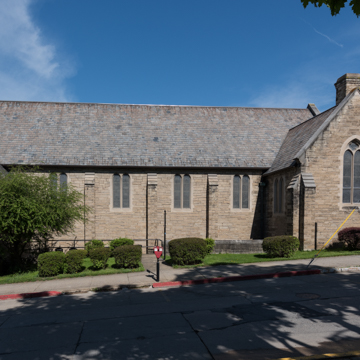Trinity's architect, a descendant of four generations of French architects and engineers, served for fifty years as the chief architect of the Cathedral of St. Peter and Paul (the Washington National Cathedral) in Washington, D.C. Trinity, a sophisticated sandstone building in an English Neo-Gothic style, demonstrates Frohman's expertise at a much reduced scale. The sanctuary, in the traditional shape of a Latin cross, has a stone floor, smooth plastered walls, windows framed with limestone surrounds, an open timber ceiling, and handsomely carved oak furnishings.
The church's great glory is its stained glass windows, composed primarily of glass made by the Blenko Company of Milton, West Virginia. Frohman referred the church's fine arts committee to several noted stained glass firms, and at his instigation, the committee visited the National Cathedral and other churches before deciding on an iconographic program for the windows and selecting a studio. As it turned out, four studios are represented: Burnham; Pittsburgh Stained Glass Studios; Reynolds, Francis and Rohnstock; and Willet. Burnham's impressive Trinity Window, a triple lancet above the altar, shows Christ in Majesty surrounded by medallions depicting events in His life.

